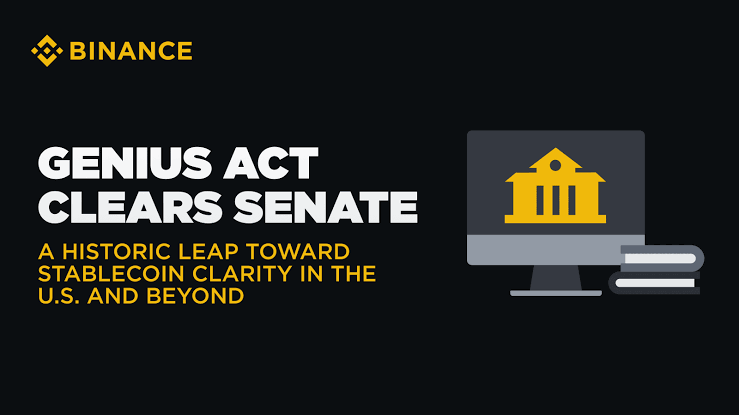Senate Clears Path for Stablecoin Regulation with GENIUS Act

Introduction
On June 17, 2025, the U.S. Senate made history by passing the GENIUS Act—short for Guiding and Establishing National Innovation for U.S. Stablecoins Act—in a decisive 68–30 bipartisan voteinvestopedia.com+11reuters.com+11trmlabs.com+11. This breakthrough marks the first-ever federal framework for stablecoins and is poised to reshape the regulatory landscape for one of crypto’s most critical pillars. With stablecoins now boasting a combined market capitalization of roughly $251.7 billion—a 22 % jump in 2025—now is the moment to unpack what this law entails, how it moves crypto from niche to mainstream, and the tensions simmering beneath the surface trmlabs.com+2reuters.com+2natlawreview.com+2.
1. What the GENIUS Act Requires
1.1 Full Liquid Asset Backing & No Rehypothecation
Issuers must maintain a strict 1:1 reserve ratio, holding U.S. dollars, demand deposits, or short-term Treasury billswith maturities of 93 days or less. Crucially, rehypothecation—using these reserves as collateral elsewhere—is explicitly prohibited kpmg.com+3natlawreview.com+3reuters.com+3.
1.2 Tiered Oversight & Licensing
- State-qualified issuers with issuance under $10 billion may choose certified state supervision.
- Federal-qualified issuers, including those over $10 billion or nonbank national charters, fall under federal oversight, led primarily by the OCC (Office of the Comptroller of the Currency).
Oversight responsibilities are divided among the Federal Reserve, FDIC, NCUA, and OCC, with formal regulations due within 12 months of enactment en.wikipedia.org+4kpmg.com+4natlawreview.com+4.
1.3 Transparency, Audits & Certifications
- Monthly public disclosure of reserve composition, reviewed by an independent accounting firm and certified by the CEO and CFO.
- Annual GAAP-based audits are mandatory for issuers with more than $50 billion in stablecoin circulationnatlawreview.com+3kpmg.com+3reuters.com+3theblock.co+2businessinsider.com+2blockworks.co+2.
1.4 Consumer Protections & Bankruptcy Priorities
Issuers must publish clear redemption policies and cannot describe their coins as U.S. legal tender, government-issued, or FDIC insured. In insolvency events, token holders receive priority claims—an important protection not previously guaranteed kpmg.com.
1.5 AML & Sanctions Compliance
Stablecoin issuers are now defined as financial institutions under the Bank Secrecy Act and related statutes. Requirements include transaction monitoring, record-keeping, and suspicious activity reporting—core elements of any AML regime kpmg.com+1natlawreview.com+1.
2. Market Reverberations 🌐
2.1 Record-Breaking Market Cap
The stablecoin ecosystem just saw its market cap hit $251.7 billion, up 22 % this year. This surge came in the wake of the Senate vote, signaling strong investor confidence reuters.com. Earlier press already put the total near $250.3 billion, with dominant players like Tether (USDT at $153 billion) and USDC ($60‑61 billion) leading the pack theblock.co.
2.2 Corporate & Institutional Catalysts
- Circle (USDC) stock exploded by 27 % post-vote, with its market cap soaring to $32.8 billionreuters.com+3marketwatch.com+3reuters.com+3.
- Coinbase, co-owner of USDC, saw its shares surge by roughly 16–17 % on optimism surrounding the new regulatory framework .
Broader corporate backing is growing: Meta, Walmart, Visa, Mastercard, and traditional financial institutions such as Bank of America and Morgan Stanley are all exploring use cases or pilots businessinsider.com.
2.3 Economic Ripples
The GENIUS Act’s requirement for issuers to back with short-term Treasuries could significantly boost demand for government debt. Analysts warn of interest rate volatility—especially in the short-term—and potential liquidity impacts on broader markets apnews.com+10investopedia.com+10businessinsider.com+10.
3. Political Tensions & Industry Friction
3.1 President Trump & Conflict Exemptions
The bill exempts Presidential family members, even as Trump’s World Liberty Financial sold approximately $57 million worth of USD1, a digital token issued via its stablecoin reuters.com+4apnews.com+4investopedia.com+4. Critics complain that banning Congress members but not the President undermines regulatory integrityinvestopedia.com+1apnews.com+1.
3.2 AML Gaps & Tech Giants
Figures like Sen. Elizabeth Warren have raised alarms, warning that the legislation is “flawed,” lacks robust AML safeguards, and could pave the way for Big Tech to dominate, potentially threatening financial stability and national security reuters.com.
3.3 Federal vs. State Dispute
The Conference of State Bank Supervisors has cautioned against granting uninsured entities nationwide money-transmission authority without sufficient host-state oversight reuters.com. This tug-of-war reflects deeper tensions about jurisdiction and regulation.
4. What’s Coming Next: House, White House & Implementation
4.1 House Floor Ahead
The bill is now under consideration in the Republican-majority House, where amendments—especially around AML and foreign issuers—are expected. Meanwhile, there's speculation that the House may fold stablecoin rules into broader omnibus crypto legislation like the CLARITY Act pymnts.com.
4.2 Presidential Timeline
President Trump, via his digital advisory board, has urged “passage before August,” to coincide with Congress’s recess. If the House approves, a signature may arrive by late summer, solidifying the GENIUS Act as law natlawreview.com.
4.3 Rulemaking & Regulatory Rollout
Post-signature, regulators have 12 months to issue guidance on licensing, capital buffers, liquidity standards, and compliance rules. After that, there will be an 18‑month transition before the law takes full effect—or 120 days post‑regulation, whichever is later .
5. Broader Significance & Future Outlook
5.1 A New Era of Trust
Regulatory clarity can cultivate public confidence: fully backed reserves, audits, and strong consumer protections provide credibility that was long missing. This positions stablecoins as practical vehicles for everyday payments, remittances, and programmable finance .
5.2 Integration with Finance & Tech
With clarified rules, stablecoins may flourish in traditional financial infrastructure and corporate ecosystems. Projects from banks and fintechs to Wal‑Mart, Amazon, and Meta could gain legal footing to build payment stacks atop stablecoins .
5.3 Risks on the Horizon
Heightened Treasury demand may compress yields and tighten liquidity for others. AML weaknesses and executive carve-outs remain contentious and may need correcting during House-House reconciliation .
5.4 Global Competitiveness
As regions like the EU (MiCA) and Hong Kong roll out stablecoin frameworks, the GENIUS Act signals U.S. ambition to lead in digital currency regulation, integrating crypto into its financial system more seamlessly .
Conclusion
The Senate’s passage of the GENIUS Act is a watershed moment. It erects pillars of certainty around reserve backing, transparency, consumer rights, and unified oversight—finally anchoring stablecoins in federal law.
Yet, the journey is not over. Legislative revisions in the House, stronger compliance measures, and a presidential signature lie ahead. The market is buoyant—Circle and Coinbase are surging, issuance is broadening, and the global stablecoin infrastructure is expanding.
Key Takeaways:
| Theme | Insight |
|---|---|
| Regulatory Clarity | 1:1 backing, audits, and AML requirements establish core trust anchors |
| Institutional Integration | Banks, fintechs, corporates primed to adopt |
| Market & Policy Risks | Treasury yield dynamics and regulatory carve-outs need guardrails |
| Global Stakes | U.S. positioning matters as others move ahead |
What to Watch Next
- House Negotiations – Will revisions tighten AML provisions, or open doors to Big Tech?
- Regulatory Rulebooks – Expect capital and liquidity regulations that shape operational models.
- Market Response – Will Treasury rates adjust as issuer demand climbs?
- Next Generation of Stablecoins – Could algorithmic or non-payment variants arise, and how will the Act touch them?
The GENIUS Act isn’t just a law—it’s a launchpad. For crypto’s silent workhorse, it may mark the moment stablecoins begin their ascent from niche instruments to foundational fixtures of finance.
Internal Mitosis Links & Glossary References
- Bitcoin
- Blockchain
- Cryptocurrency
- Mitosis Core: https://university.mitosis.org/mitosis-core
- Governance: https://university.mitosis.org/governance
- Glossary: https://university.mitosis.org/glossary/
- Ecosystem Connections: https://university.mitosis.org/ecosystem-connections


Comments ()